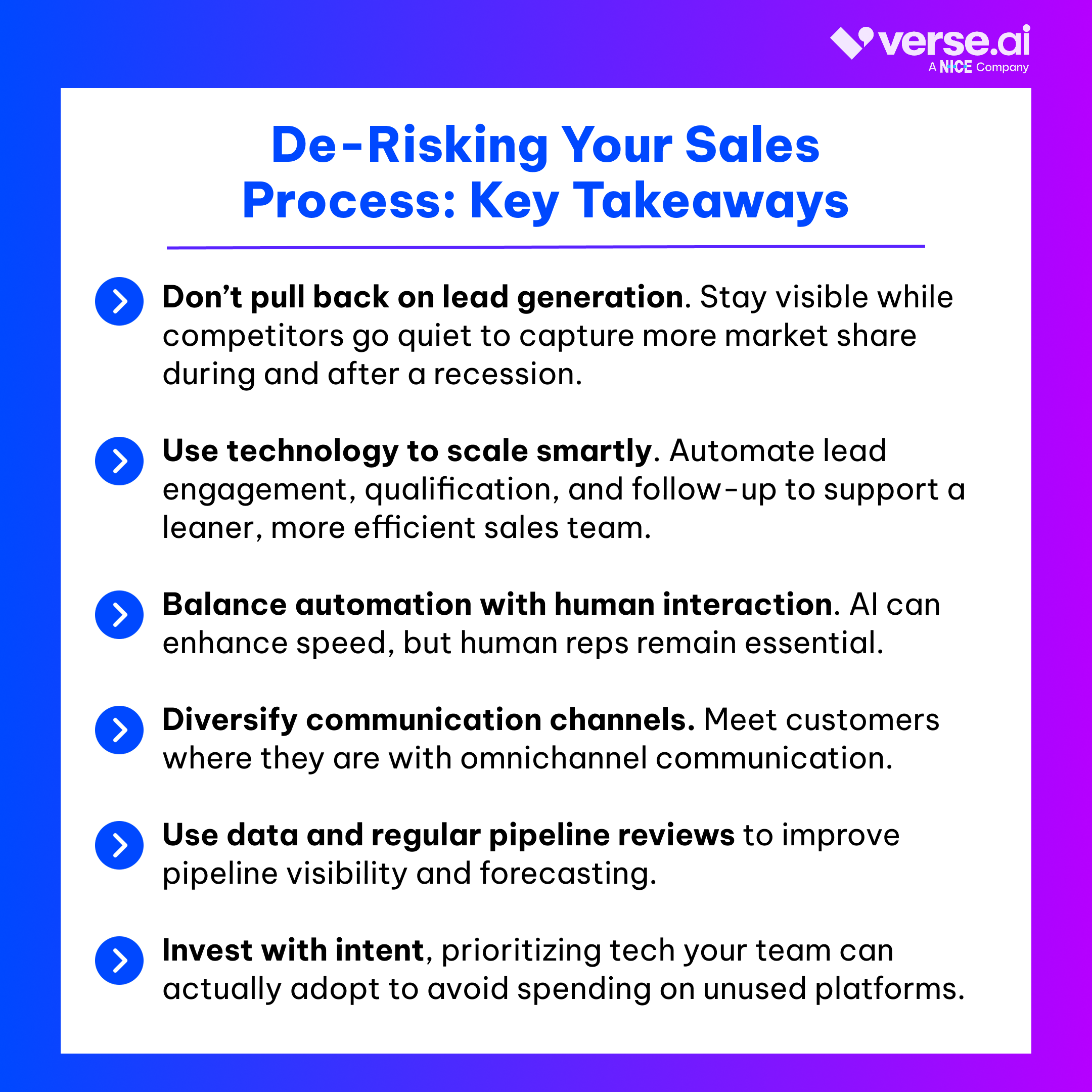In the current economic climate of inflation, possible recession, and consumer hesitancy, sales and marketing teams want to eliminate risks and shift into protection mode.
How can sales and marketing teams mitigate potential risks in an inflationary environment and grow ROI?
If you’re looking for a recession sales strategy that actually works, this blog will provide practical advice for B2C teams under pressure right now.
Let’s go over five key tips that are often overlooked (especially tip #5).
Why risk mitigation matters for a recession sales strategy
In a recession or inflationary market, the margin for error in sales and marketing shrinks dramatically.
Businesses must fight for a smaller pool of demand.
As consumer behavior becomes more cautious, decision cycles lengthen, and competition tightens:
- Your revenue is more vulnerable to volatility.
- Your sales processes must be more efficient, measurable, and resilient than ever.

Without a risk-mitigation mindset, sales teams often fall into reactive patterns: cutting spend blindly, pausing innovation, or overloading reps with unrealistic quotas.
However, these knee-jerk reactions not only fail to protect the pipeline, but they compound the damage.
That’s why it’s critical to take proactive steps to de-risk your recession sales strategy early.
By strategically implementing technology, reinforcing your team with the right support, adapting your outreach methods, and doubling down in the right places, you can protect your bottom line and even gain market share – while the competition retreats.
Here are five key steps to reduce sales risk and inflation impact on sales.
Double down on lead generation (not pull back)
With the early signs of recession on the horizon, the instinct to cut marketing budgets is common, but risky.
Though it’s tempting to cut lead generation spending, it’s actually beneficial to do the exact opposite.
While others (your competitors) are pulling back due to recession fears, now is the time to double down on lead generation efforts and stay top-of-mind for your prospects. When the recession ends, you are more likely to come out on top.
“Flat, across-the-board cuts starve promising initiatives of resources at precisely the point when the company could overtake weakened competitors… [T]he objective should be to balance the short-term imperative to free resources with the opportunity to invest for long-term growth.” – Donald Sull and Charles Sull, MIT Sloan
According to Nielsen, 75% of recessions end in a year or less, with 30% lasting only two quarters. In addition, brands that go off-air lose 2% of their long-term revenue each quarter, which results in equity losses that can take 3-5 years to recover.
For this reason, cutting marketing budget will save some cash in the short-term, but disadvantage your company as soon as the recession ends—which could be much sooner than you think.
Historically, in economic downturns, companies that maintained or even increased their advertising spend were able to capture market share from the competition.
For example, Airbnb vs. VRBO:
In early 2021, Airbnb significantly decreased their ad spend. VRBO, on the other hand, spent 10x more on advertising than Airbnb during this period. While VRBO bookings improved by 61%, Airbnb bookings dropped 15%.
Moral of the story: continue to generate leads during a recession, and if possible, increase lead generation budget.
When doing so, be sure to prioritize high-performing and high-intent channels such as organic, referrals, and paid retargeting. Use marketing data and analytics to identify which channels are working best for you, and double down.
Leverage the right technology
During hiring freezes, use technology to your advantage. The right tech can multiply your sales reps’ impact and help your team scale when there is uncertainty around headcount and other resources.
Tech such as AI can help with:
- Automated lead engagement: Sales reps waste hours chasing cold leads. To empower sales and marketing efforts, AI can respond to every lead instantly around the clock and automate aspects of follow-up and nurture.
- Task management: AI saves your team time and effort on low-effort tasks such as CRM updates.
- AI-powered qualification: Not every lead is worth a call. AI-enabled lead qualification weeds out unqualified leads so your team can prioritize the highest-intent, right-fit buyers.
- Performance visibility: Sales leaders need real-time dashboards to understand what’s working and what’s not. CRMs and customer engagement platforms eliminate silos and help with visibility.
However, it’s vital to prioritize smart spending when evaluating AI.
While investing in sales and marketing technology is an objective for many companies, the technology is often underutilized (or not utilized at all) due to lack of proper expertise, alignment, integration, or use cases.
Avoid spending on helpful new tech without the staff or staff knowledge to utilize it properly. This is why fully-managed solutions like Verse exist—to bridge the gap of any adoption and implementation difficulties that can render helpful solutions a waste.
Balance new technology with human touch
While technology can be very useful in recession-proofing your sales and marketing teams, balance is paramount to success.
Human interaction remains vital to building and maintaining strong customer relationships.
Avoid over-automation that eliminates the human touch; technology such as AI should enhance your team and your relationships, not replace them.
For example, speed and human touch are both important elements of a positive customer experience:
- According to PWC research, 82% of U.S. consumers want more human interaction.
- At the same time, 53% of people cite waiting too long for replies as the most frustrating part of interacting with businesses, and will switch to a competitor if the wait is too long.
Using AI to reply quickly can help your team better meet customer expectations, while a human representative can get back to qualified leads when the timing is right.
Let AI tools handle the easy stuff, including:
- 24/7 response
- Appointment setting
- CRM updates
- Lead qualification
- Automated nurture
Save the bottom of funnel stuff, like personal calls, live demos, and expert consultations, for your human team.
AI should streamline the conversion process for qualified leads, quickly and easily moving from the top of the funnel to the middle and bottom for your sales team.
Diversify communication channels
Similarly, a balanced approach to communication channels can improve conversions and build resilience. When every sale counts, relying on just one or two communication channels can leave opportunities on the table.
As competition tightens, it’s vital that your sales and marketing efforts are meeting customers exactly where they are.
During economic uncertainty, customers are more cautious, slower to reply, and less likely to be looking for products and services, omnichannel follow-up is key.
Across industries, consumers value their options.
Make sure that your business is present and available across channels, including:
- Email (good for lead nurturing and updates)
- SMS (quick, personal, and ideal for service industries)
- Phone (for building trust in complex conversations)
- Live chat or digital assistants (for website capture)
- Social media (for product updates and casual conversations)
The key isn’t just using more channels—it’s using them in the right places in the customer journey.
For example, SMS and email are great for the early stages of awareness and interest, moving leads towards phone and in-person engagements as they move through the funnel.
For many companies, harnessing a platform (like Verse) to orchestrate multi-channel engagement can prevent dropped leads and help sales teams prioritize the hottest opportunities.
Invest in pipeline visibility
During volatile economic times, many teams fly blind, making decisions based on gut feel instead of data. However, inflation and demand shifts make historical patterns unreliable.
Pipeline visibility and forecasting aren’t just about predicting revenue—they’re about managing risk.
Sales forecasting and pipeline management
Sales forecasting estimates sales revenue over a given period of time (month, quarter, etc.). For an accurate forecast, the pipeline must also be accurate.
Sales pipeline management tracks the progress of active deals. In order to have accurate pipeline management, sales leadership must ensure that each deal in the pipeline is well-estimated in terms of revenue, close date, and percentage likelihood of closing.
Pipeline management helps you spot vulnerabilities in your sales process and understand where leads are stalling.
Companies with optimized sales pipelines reported a 28% higher revenue growth rate compared to those with poorly managed pipelines.
During inflationary periods, prospects take longer to commit, ghost more frequently, and rethink purchases mid-funnel. If you’re not tracking your pipeline closely, you could be overestimating your revenue.
Strengthen pipeline accuracy with regular pipeline reviews and stress tests.
These are focused check-ins with account executives where leadership can validate opportunity stage placement, expected contract value, and projected close date by examining seller activity and confirming buyer signals.
Key metrics for pipeline visibility
Improving forecast accuracy and pipeline visibility allow for smarter budgeting decisions, right-sized hiring plans, and better confidence—all especially important in an economic downturn.
Key metrics for more accurate pipeline visibility include:
- Pipeline velocity (how fast deals are moving)
- Win rates
- Lost leads and missed appointments
- Forecast confidence (how accurate your reps estimate)
- Deal health (how many deals are stalling?)
- Average touchpoints needed per deal
As mentioned earlier, the right technology investments are key during an inflationary period. Technology can help manage your pipeline and monitor these metrics with real-time data.
Examples include:
- A CRM or sales enablement platform, which you may already use, can surface these insights without much manual work.
- AI tools can automatically flag at-risk deals, suggest follow-ups, visualize pipeline stages in real time, and save your reps hours every week.
- Fully-managed platforms like Verse can automate cold lead revival, track touchpoints, and provide real-time conversation data.
The earlier you spot risk in your pipeline, the more power you ultimately have.
Recession ≠ retraction
Economic uncertainty and recession fears put pressure on even the most experienced sales teams. But while recessions bring challenges, they also bring opportunities for smart operators.
A well-planned recession sales strategy is about de-risking your process, doubling down on what works, and building a more resilient, tech-enabled foundation for the future.
If you’re looking for a way to increase efficiency and responsiveness without adding headcount, Verse’s fully-managed AI can help your team save time, connect with leads, and prioritize hot opportunities.
Our platform acts as a scalable AI agent that amplifies your team by providing:
- 24/7 instant response via SMS to ensure that every lead is contacted immediately.
- Consistent follow-up for every lead, with customizable, ongoing outreach and nurture for up to six months.
- Automatic lead qualification to help your team focus on high-quality leads.
- Omnichannel communications via text, phone call, and email.
- Compliance assistance and expert guidance.
If Verse sounds like a fit for you, check out our ROI calculators to see your personalized Verse ROI – or hop into a demo today!
Recession sales strategy: Key takeaways

How to increase sales during recession: FAQ
What is a recession sales strategy?
A recession sales strategy is a plan designed to help businesses maintain or grow revenue during economic downturns. It focuses on reducing risk, improving sales efficiency, and increasing ROI through strategic lead generation, technology adoption, and smarter pipeline management.
How can I generate leads during a recession without overspending?
Rather than cutting your marketing budget, reallocate it toward high-performing, high-intent channels. Using tools like AI-powered platforms can also help you stretch your resources by automating lead engagement and qualification.
Why is it important to balance technology with human touch?
While technology can automate and accelerate parts of your sales process, it shouldn’t replace personal interaction. Customers still value human conversations. Use AI for speed and scale, and let your team handle the real relationship-building moments.
What channels should I use to reach customers in a downturn?
A multi-channel approach is key. Combine SMS, email, phone, chat, and even social media to meet customers where they are. Each channel plays a different role depending on where the buyer is in the funnel.
How do I improve pipeline visibility during inflation or recession?
Start by running regular pipeline reviews to confirm deal stage, close probability, and projected revenue. Use a CRM or AI platform to track pipeline velocity, win rates, and deal health in real time. Better visibility allows for smarter forecasting, budget planning, and team management.


